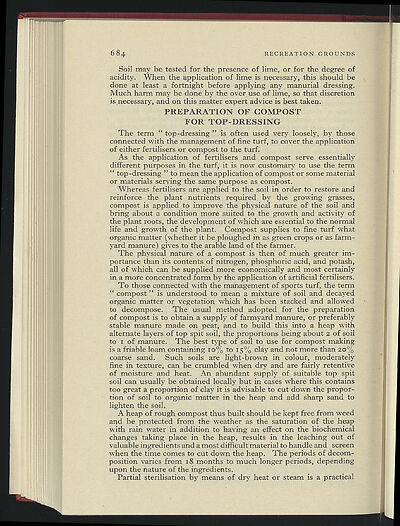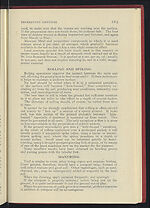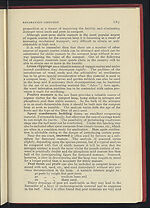1950-51
(714)
Download files
Complete book:
Individual page:
Thumbnail gallery: Grid view | List view

I
E ?
i
684
RECREATION GROUNDS
Soil may be tested for the presence of lime, or for the degree of
acidity. When the application of lime is necessary, this should be
done at least a fortnight before applying any manurial dressing.
Much harm may be done by the over use of lime, so that discretion
is necessary, and on this matter expert advice is best taken.
PREPARATION OF COMPOST
FOR TOP
-
DRESSING
The term " top-dressing " is often used very loosely, by those
connected with the management of fine turf, to cover the application
of either fertilisers or compost to the turf.
As the application of fertilisers and compost serve essentially
different purposes in the turf, it is now customary to use the term
" top-dressing " to mean the application of compost or some material
or materials serving the same purpose as compost.
Whereas fertilisers are applied to the soil in order to restore and
reinforce the plant nutrients required by the growing grasses,
compost is applied to improve the physical nature of the soil and
bring about a condition more suited to the growth and activity of
the plant roots, the development of which are essential to the normal
life and growth of the plant. Compost supplies to fine turf what
organic matter (whether it be ploughed in as green crops or as farm-
yard manure) gives to the arable land of the farmer.
The physical nature of a compost is then of much greater im-
portance than its contents of nitrogen, phosphoric acid, and potash,
all of which can be supplied more economically and most certainly
in a more concentrated form by the application of artificial fertilisers.
To those connected with the management of sports turf, the term
" compost " is understood to mean a mixture of soil and decayed
organic matter or vegetation which has been stacked and allowed
to decompose. The usual method adopted for the preparation
of compost is to obtain a supply of farmyard manure, or preferably
stable manure made on peat, and to build this into a heap with
alternate layers of top spit soil, the proportions being about
2
of soil
to i of manure. The best type of soil to use for compost making
is a friable loam containing. io% to
15%
clay and not more than
20%
coarse sand. Such soils are light-brown in colour, moderately
fine in texture, can be crumbled when dry and are fairly retentive
of moisture and heat. An abundant supply of suitable top spit
soil can usually be obtained locally but in cases where this contains
too great a proportion of clay it is advisable to cut down the propor-
tion of soil to organic matter in the heap and add sharp sand to
lighten the soil.
A heap of rough compost thus built should be kept free from weed
and be protected from the weather as the saturation of the heap
with rain water in addition to having an effect on the biochemical
changes taking place in the heap, results in the leaching out of
valuable ingredients and a most difficult material to handle and screen
when the time comes to cut down the heap. The periods of decom-
position varies from
18
months to much longer periods, depending
upon the nature of the ingredients.
Partial sterilisation by means of dry heat or steam is a practical
l
E ?
i
684
RECREATION GROUNDS
Soil may be tested for the presence of lime, or for the degree of
acidity. When the application of lime is necessary, this should be
done at least a fortnight before applying any manurial dressing.
Much harm may be done by the over use of lime, so that discretion
is necessary, and on this matter expert advice is best taken.
PREPARATION OF COMPOST
FOR TOP
-
DRESSING
The term " top-dressing " is often used very loosely, by those
connected with the management of fine turf, to cover the application
of either fertilisers or compost to the turf.
As the application of fertilisers and compost serve essentially
different purposes in the turf, it is now customary to use the term
" top-dressing " to mean the application of compost or some material
or materials serving the same purpose as compost.
Whereas fertilisers are applied to the soil in order to restore and
reinforce the plant nutrients required by the growing grasses,
compost is applied to improve the physical nature of the soil and
bring about a condition more suited to the growth and activity of
the plant roots, the development of which are essential to the normal
life and growth of the plant. Compost supplies to fine turf what
organic matter (whether it be ploughed in as green crops or as farm-
yard manure) gives to the arable land of the farmer.
The physical nature of a compost is then of much greater im-
portance than its contents of nitrogen, phosphoric acid, and potash,
all of which can be supplied more economically and most certainly
in a more concentrated form by the application of artificial fertilisers.
To those connected with the management of sports turf, the term
" compost " is understood to mean a mixture of soil and decayed
organic matter or vegetation which has been stacked and allowed
to decompose. The usual method adopted for the preparation
of compost is to obtain a supply of farmyard manure, or preferably
stable manure made on peat, and to build this into a heap with
alternate layers of top spit soil, the proportions being about
2
of soil
to i of manure. The best type of soil to use for compost making
is a friable loam containing. io% to
15%
clay and not more than
20%
coarse sand. Such soils are light-brown in colour, moderately
fine in texture, can be crumbled when dry and are fairly retentive
of moisture and heat. An abundant supply of suitable top spit
soil can usually be obtained locally but in cases where this contains
too great a proportion of clay it is advisable to cut down the propor-
tion of soil to organic matter in the heap and add sharp sand to
lighten the soil.
A heap of rough compost thus built should be kept free from weed
and be protected from the weather as the saturation of the heap
with rain water in addition to having an effect on the biochemical
changes taking place in the heap, results in the leaching out of
valuable ingredients and a most difficult material to handle and screen
when the time comes to cut down the heap. The periods of decom-
position varies from
18
months to much longer periods, depending
upon the nature of the ingredients.
Partial sterilisation by means of dry heat or steam is a practical
l
Set display mode to:
![]() Universal Viewer |
Universal Viewer | ![]() Mirador |
Large image | Transcription
Mirador |
Large image | Transcription
| Games and sports in the army > 1950-51 > (714) |
|---|
| Permanent URL | https://digital.nls.uk/248816770 |
|---|
| Description | 'Games and Sports in the Army' was an annual publication produced by the British War Office between the 1930s and 1960s. This included the Second World War. It outlines the rules and regulations for games and sports played by members of the armed forces. It features names and photographs of team members, and examples of contemporary advertising. |
|---|---|
| Shelfmark | GWB.52 |

